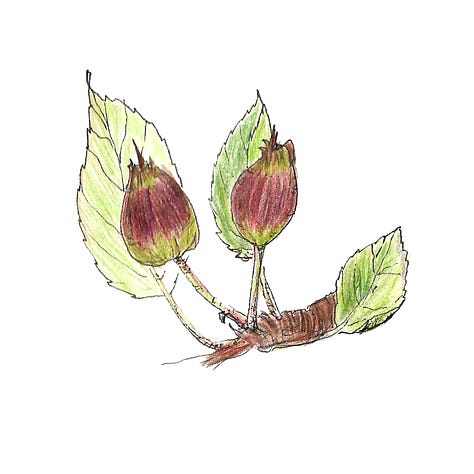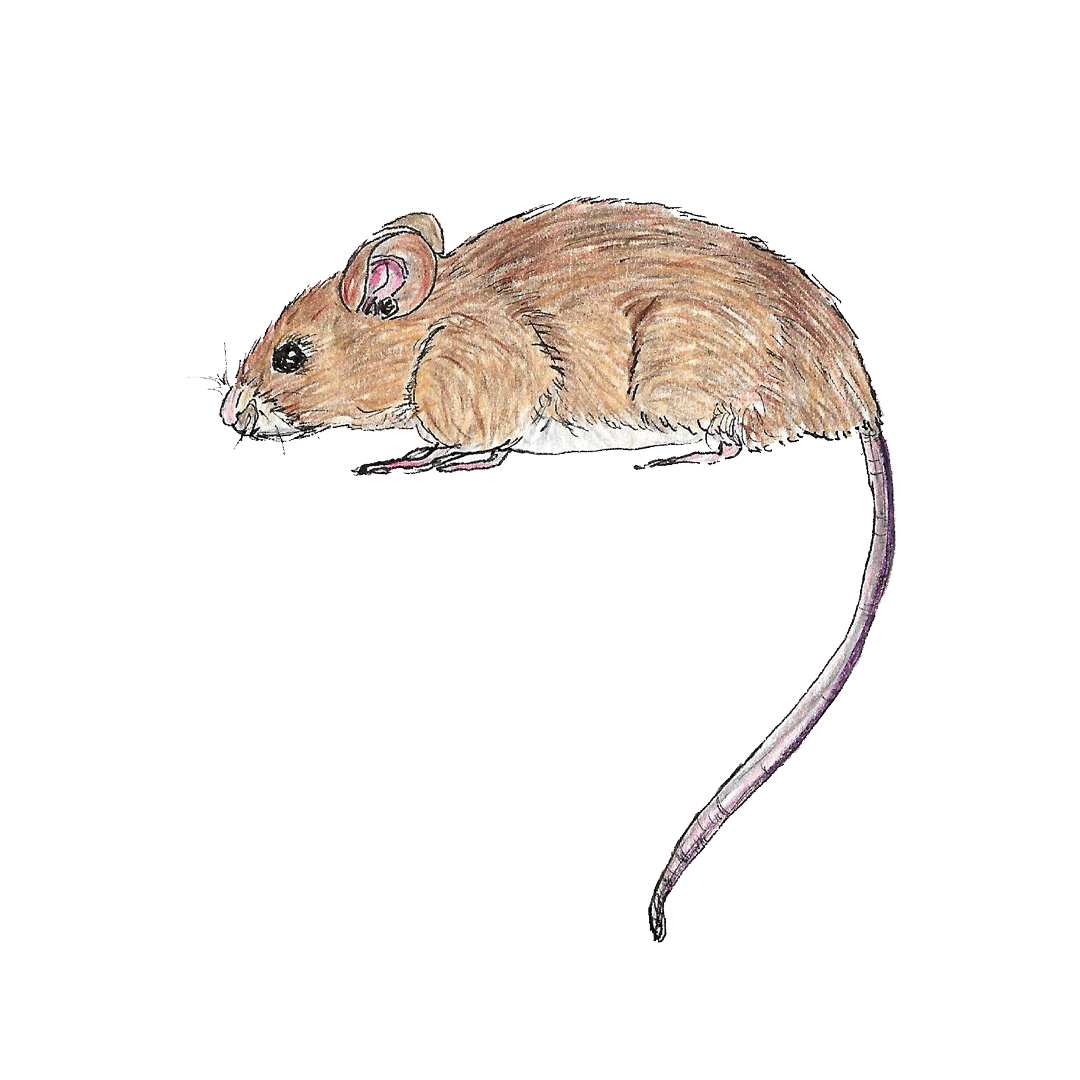What a busy month for wildlife this June has been. I’ve spent lots more time outside as the weather has finally improved and have started some baby-steps to outdoor sketching by sitting in the garden and drawing things that catch my eye.
1st - 7th June
At the beginning of June 2024, I signed-up to International Nature Journaling Week - a project to encourage people around the world to connect with nature through journaling. This year’s theme was about ‘celebrating the cycles of life’. Throughout the week I spent some time every day thinking about the prompt that was set, deciding what I was going to draw, and then writing a few sentences related to the illustration.
1st June - Germination & Emergence
I spent some time looking very closely at some lettuce seeds, including scattering them onto my page and drawing around them to create the contours for a lettuce seed island! I also had a quick sketch of the seed packet as my lettuce seedlings have been very slow to germinate this year and weren’t making much of a show yet. I did, however, make a watercolour and ink study of a garden snail (Cornu aspersa) that I found in my salad bed - before quickly relocating him to another part of the garden where he would do less damage!
2nd June - Growth & Development
I’m always excited when the apple trees start to set their little fruitlets. I spent some time sitting in front of the tree, trying to capture all the colours and textures of these with coloured pencil.



3rd June - Metamorphosis & Transformation
When I was sowing some root veg seeds today, I found a moth pupa in the bed that had brassicas in last year. Moth pupae all look very similar, but it could be about to become an Angle Shade Moth, as they feed on herbaceous plants and are common in coastal areas, like ours. I spent some time sketching the pupa and learning about the different parts of the moth that it will become, as well as doing a quick coloured pencil sketch of the Angle Shade Moth.
4th June - Reproduction & Replication
We have a family of house sparrows nesting in the garden this year. Refilling the seed feeder has become a daily job now that the young have fledged - they spend most of the day jostling for position! House sparrows have 3-4 clutches with 4-5 eggs in each through the spring/summer, so doubtless the garden will continue to be filled with their bickering and busyness for a while to come. For today’s entry, I painted a house sparrow egg in watercolour - as you can see, they’re very small!
5th June - Fruiting & Dispersal
The first Scottish strawberries appeared in the supermarket a few weeks ago, but our garden strawberries are still quite a way off being ready!



6th June - Decay & Decomposition
Our house was built in the 1950s and over the years a lot of mature trees have clearly been removed, as we still keep finding tree stumps dotted about the garden. This also means that at different times of year we get eruptions of fungi, feeding on the dead wood. This beauty appeared last month and is still going strong. We’re relatively confident it is Dryad’s Saddle - meaning it is edible, although we won’t be chancing it - some of the brackets are more than 30cm across!
7th June - Renewal & Regeneration
Today I have learnt about ‘volunteer’ plants as a concept, although I’ve appreciated them for their efforts in the veg garden for years! Volunteer plants are those which self-seed and have something to offer, either by attracting pollinating insects, or repelling bugs/snails, or even acting as a sacrifice to the latter in favour of the crop you’re trying to grow! Nasturtium seedlings pop-up every year now - I sowed them purposefully about 5 years ago and have never had to buy another packet of seeds. They’re great for attracting insects and also provide quite good ground cover, thus discouraging weeds.


This full week of nature journaling was an interesting and educational experience, but I definitely don’t think this is something I want to continue on such a regular basis - it was quite a lot of work to create an entry every day! I suspect that I’ll dip in-and-out of nature journaling, doing a day here or there when the mood takes me - and I’m happy with that being my rhythm.
11th June
I was so excited to notice a field mouse in the garden this evening. It was still quite early - about 6.30pm - when I became aware that in addition to the family of sparrows hopping around beneath our seed feeder, there was also something significantly smaller, scurrying busily to collect the seeds discarded by the birds. As my husband is a keen photographer, he had a spare Go Pro that he set-up just in front of the feeder (complete with its own little hide made from twigs and leaves).
We have since spent many happy minutes watching back the recorded footage of the mice. We’ve always tried to garden in a way that encourages wildlife, with plenty of ‘wild’ corners, piles of dead wood, etc - so it was lovely to see some other creatures enjoying our efforts!
20th June
It was beautiful weather this morning when I set off with Mick (our border terrier) for our morning walk - so we decided to do one of his longer routes, down through a lovely park maintained by volunteers, along by the river Tweed and then up a path known as Askew’s Walk, which was put in by the Ramblers’ Association and cuts up next to a stream and a wooded plantation on one side, with farmer’s fields on the other. The final leg goes back along an old road that has fantastic views up the Tweed valley into Scotland as well as across to the Cheviots and down the Coast. This walk is always a great one for wildlife spotting - I’ve seen an otter and deer (!) swimming in the river (not together, I might add - two separate occasions); I’ve met a fox crossing the path; I’ve seen all manner of wading birds and heard the relentless drilling of a woodpecker.
I was already enjoying the abundance of wild flowers as we walked along the river, when a bird suddenly flew in front of me and landed obligingly just ahead of me on a fence post. He was finch-shaped with a rosy pink breast - not something I’d ever seen before. A quick Google (oh what did we do before phones and the internet?!) and I discovered that I had seen a linnet! Sadly, I wasn’t quick enough to snap a picture of him - I was too busy enjoying the moment - but I did mark the occasion by working on an ink and watercolour sketch from a photo reference once I got home.

If you aren’t familiar with the linnet, they’re a member of the finch family and are still quite widespread across the UK, although numbers have dropped significantly over the past few decades so that it is now at 'Red' on the Conservation Status list. The striking pink plumage is only found on the males in summer - so they're less easy to spot at other times of the year. They feed on seeds and prefer open land with thick bushes, including heathland and gardens. It was very popular during the Victorian and Edwardian period as a caged bird because of its tuneful songs - sadly I didn't hear my linnet sing, as it had a mouthful of dried grass that it was clearly taking somewhere to add to a nest.
Another one for the rare bird bingo (which is much easier to complete here in rural Northumberland where we seem to be blessed with larger populations of all sorts of wildlife that is struggling elsewhere!)
Have you spotted anything in nature this month that brought you joy?




